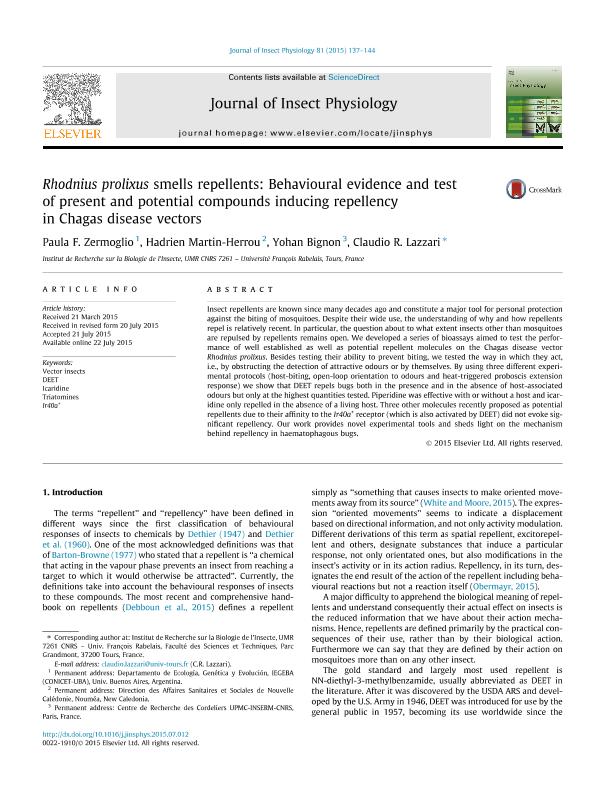Mostrar el registro sencillo del ítem
dc.contributor.author
Zermoglio, Paula Florencia

dc.contributor.author
Martin Herrou, Hadrien
dc.contributor.author
Bignon, Yohan
dc.contributor.author
Lazzari, Claudio Ricardo

dc.date.available
2018-06-28T18:20:41Z
dc.date.issued
2015-10
dc.identifier.citation
Zermoglio, Paula Florencia; Martin Herrou, Hadrien; Bignon, Yohan; Lazzari, Claudio Ricardo; Rhodnius prolixus smells repellents: Behavioural evidence and test of present and potential compounds inducing repellency in Chagas disease vectors; Pergamon-Elsevier Science Ltd; Journal of Insect Physiology; 81; 10-2015; 137-144
dc.identifier.issn
0022-1910
dc.identifier.uri
http://hdl.handle.net/11336/50444
dc.description.abstract
Insect repellents are known since many decades ago and constitute a major tool for personal protection against the biting of mosquitoes. Despite their wide use, the understanding of why and how repellents repel is relatively recent. In particular, the question about to what extent insects other than mosquitoes are repulsed by repellents remains open. We developed a series of bioassays aimed to test the performance of well established as well as potential repellent molecules on the Chagas disease vector Rhodnius prolixus. Besides testing their ability to prevent biting, we tested the way in which they act, i.e., by obstructing the detection of attractive odours or by themselves. By using three different experimental protocols (host-biting, open-loop orientation to odours and heat-triggered proboscis extension response) we show that DEET repels bugs both in the presence and in the absence of host-associated odours but only at the highest quantities tested. Piperidine was effective with or without a host and icaridine only repelled in the absence of a living host. Three other molecules recently proposed as potential repellents due to their affinity to the Ir40a+ receptor (which is also activated by DEET) did not evoke significant repellency. Our work provides novel experimental tools and sheds light on the mechanism behind repellency in haematophagous bugs.
dc.format
application/pdf
dc.language.iso
eng
dc.publisher
Pergamon-Elsevier Science Ltd

dc.rights
info:eu-repo/semantics/openAccess
dc.rights.uri
https://creativecommons.org/licenses/by-nc-sa/2.5/ar/
dc.subject
Deet
dc.subject
Icaridine
dc.subject
Ir40a+
dc.subject
Triatomines
dc.subject
Vector Insects
dc.subject.classification
Otras Ciencias Biológicas

dc.subject.classification
Ciencias Biológicas

dc.subject.classification
CIENCIAS NATURALES Y EXACTAS

dc.title
Rhodnius prolixus smells repellents: Behavioural evidence and test of present and potential compounds inducing repellency in Chagas disease vectors
dc.type
info:eu-repo/semantics/article
dc.type
info:ar-repo/semantics/artículo
dc.type
info:eu-repo/semantics/publishedVersion
dc.date.updated
2018-06-26T13:42:07Z
dc.journal.volume
81
dc.journal.pagination
137-144
dc.journal.pais
Países Bajos

dc.journal.ciudad
Amsterdam
dc.description.fil
Fil: Zermoglio, Paula Florencia. Centre National de la Recherche Scientifique; Francia. Consejo Nacional de Investigaciones Científicas y Técnicas. Oficina de Coordinación Administrativa Ciudad Universitaria. Instituto de Ecología, Genética y Evolución de Buenos Aires. Universidad de Buenos Aires. Facultad de Ciencias Exactas y Naturales. Instituto de Ecología, Genética y Evolución de Buenos Aires; Argentina
dc.description.fil
Fil: Martin Herrou, Hadrien. Centre National de la Recherche Scientifique; Francia
dc.description.fil
Fil: Bignon, Yohan. Centre National de la Recherche Scientifique; Francia
dc.description.fil
Fil: Lazzari, Claudio Ricardo. Centre National de la Recherche Scientifique; Francia. Consejo Nacional de Investigaciones Científicas y Técnicas; Argentina
dc.journal.title
Journal of Insect Physiology

dc.relation.alternativeid
info:eu-repo/semantics/altIdentifier/url/http://www.sciencedirect.com/science/article/pii/S0022191015001602
dc.relation.alternativeid
info:eu-repo/semantics/altIdentifier/doi/http://dx.doi.org/10.1016/j.jinsphys.2015.07.012
Archivos asociados
